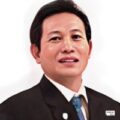In 1988, in Pontianak, west Borneo. I had the opportunity to meet, discuss, and chat with a linguistics researcher from Leiden University, Netherlands.
At that time, he introduced himself as Sander Adelaar. And post factum, 20 years later, before successfully downloading his research entitled “Salako or Badameà. Sketch grammar, texts, and lexicon of a Kanayatn dialect in West Borneo,” I still knew him by this name.
Now Adelaar has become a Professor. He is known for his expertise in the field of linguistics, especially the Kanayatn, Lara, and Badamea’ languages. According to his research findings, these Dayak languages are much more archaic. Linguistic evidence shows that the Dayak people, the native inhabitants of Borneo, have existed and remained in Varuna-dvipa, the third-largest island, before Borneo was introduced to Western travelers and writers.
It turns out that the full name of the researcher who achieved the highest academic degree, Ph.D., due to his research on the classification and investigation of the Dayak Kanayatn language, is Karl Alexander Adelaar. But, as Ernest Hemingway once said, what is a name? What matters is the substance.
Although the research object was about Dayak Salako, to provide context, Adelaar created a map of Kalimantan Dayak based on language classification. And Jangkang is included in it, within the unity of Land Dayak.
Sander Adelaar, a linguistic expert, was one of the many foreign researchers who earned the highest academic degree of Ph.D. by researching the Dayak ethnicity.
The material and formal objects of the research of this man, who wrote with his left hand, were unique. How so! Sander Adelaar studied the Indonesian language and culture as well as Austronesian languages at Leiden University. He was also a research fellow in linguistics at the Australian National University and a Humboldt Fellow at Goethe University (Frankfurt) before joining the University of Melbourne. His research focused on linguistic comparison and description, with a focus on Malay language variations in Kalimantan (where he conducted field research), Madagascar, and Taiwan. He also had an interest in oral traditions and traditional written literature in Indonesia.
What is important and relevant to Jangkang, based on Adelaar’s research results, is the study and comparative study of Dayak, especially Chapter 4, “Borneo as a Cross-Roads for Comparative Austronesian Linguistics.” According to Adelaar, the position of Malay-Polynesian languages, especially in Borneo, is crucial for understanding and comparing them with Austronesian languages.
Without research results like those conducted by Adelaar, we would never have understood the linguistic (and cultural) similarities that unite Land Dayak as a subethnic group of Dayak. Based on this linguistic similarity, Dayak Jangkang became a small part of Land Dayak.
Linguistic evidence shows that the Dayak people, the native inhabitants of Borneo, have existed and remained in Varuna-dvipa, the third-largest island, before Borneo was introduced to Western travelers and writers.
As a foreign speaker, it is understandable why Adelaar questioned the pronunciation of the Jangkang language. As an initial note, Jangkang people like to give alternative names to things/objects. It is not easy for outsiders to pronounce or understand synonyms that, in many cases, are only understood by Dayak Jangkang.
These synonyms can take more than one form. Furthermore, if written, they often do not match exactly with what is (supposed to be) pronounced. For example, it is written “Jongkang,” but the correct pronunciation is “Jongkangk.” So, the general rule in the Jangkang language is that if a word ends with “ng,” it tends to be pronounced, or there is a “k” at the end.
Thus, the names of villages in the Jangkang District, such as Kobang, Empiyang, Tangong, Lalang, and any words ending in “ng,” such as sabong (sabung), komong (kembung), cinong (condong), linong (lindung), and so on, tend to be pronounced by adding “k” to the end of the word.
Adelaar notes that the forms “mane?,” “mandey?,” “manI?,” and “man ḯ?” are adaptations of the Malay word “mandi” or Malay-Dayak “man(d)i?”
This is the subgroup of Kalimantan languages and their relationship with other exo-Kalimantan subgroups. From the map of Dayak subgroup distribution from a linguistic perspective, it can be seen how ethnicity cannot separate Dayak Jangkang from Dayak Sarawak. Adelaar attempts to challenge many theories that conclude that Riau Malay is the precursor to the Indonesian language. While that is true, it is not the archaic (original) form. According to Adelaar, the original form is actually Malay Salako, which in international texts is referred to as Salako (a Malayic Dayak language). Of course, in accordance with the principles of science, Adelaar’s antithesis still needs verification, just as he verifies the findings of previous linguistics experts.
An example of linguistic comparison for Land Dayak language is as follows:
| “mati” | “membunuh” | “tidur” | “mandi” | |
|---|---|---|---|---|
| Bekati’ | kabis | ŋamis | buus | mamu? |
| Lara? | kabih | ŋamḯh | buih | mamǘ |
| Golek | kobis | ŋkəbis | biis | mamuh |
| Nonguh | kobis | ŋkɔmis | bis | mamǘh |
| Pandu | kɔbis | ŋɔmis | biis | mane? |
| Ribun I | kobis | ŋkobis | bihis | mandey? |
| Ribun II | kɔbis | ŋkɔmis | biis | mandey? |
| Jangkang | kɔbi? | kɔmI? | bi? | manI? |
| Lintang | k(oɔ)bis | ŋkɔmis | biis | manI? |
| Aye-aye | kubəs | ŋkuməs | bis | manḯ? |
| Sungkung | kabəs | nnabəs | bə?əs | mamuh |
| Sekayam | kɔbis | ŋkɔmis | biis | Mä́mǘh |
From a linguistic perspective, there are similarities between Dayak Sarawak and Dayak Kalimantan Indonesia (distribution map of language usage in Kalimantan number 2).
Therefore, the bond of brotherhood between Dayak Sarawak and Dayak Jangkang continues to exist. It becomes even stronger with the construction of an international road connecting Jangkang-Kembayan-Sarawak to the Entekong border crossing.
Friendly visits are often made by the residents of Sarawak to Sanggau and vice versa, in the name of language and culture, kinship, and religion.*)






